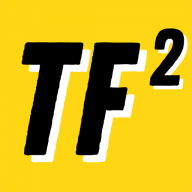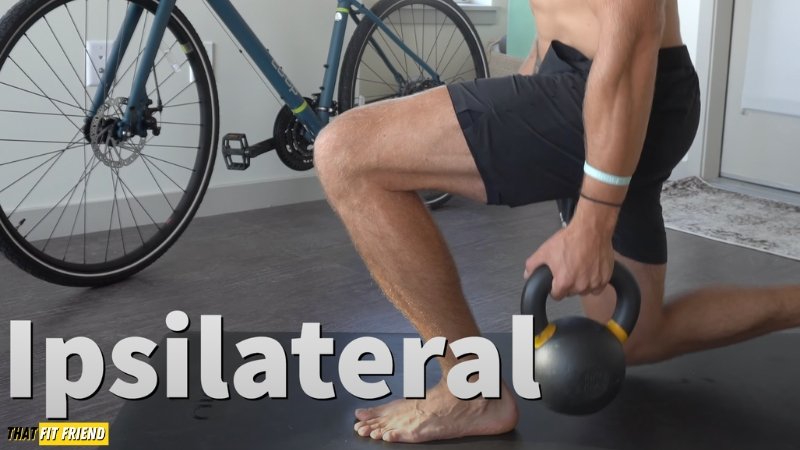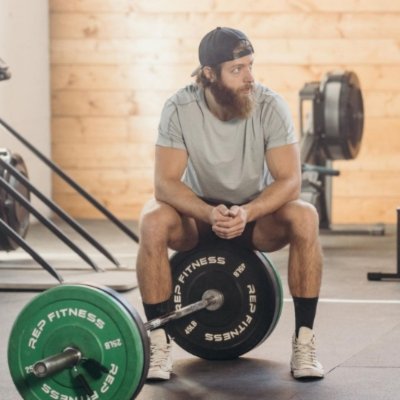In the gym, it’s normal to hold weights on both sides of the body when we’re training. This loading style is referred to as bilateral loading which refers to the distribution of weight and load to both sides of the body.
Bilateral loading is great, but it’s not the only way to load exercises for a ton of benefits. For example. ipsilateral versus contralateral loading are two other ways to load and train the body unilaterally for different benefits.
Ipsilateral lifting refers to holding a weight on the dominant side of the body that is lifting, while contralateral refers to holding weight on the offset site.
- Performing a Split Squat: Right leg lifting, holding a weight in right hand = Ipsilateral.
- Performing a Split Squat: Right leg lifting, holding a weight in the left hand = Contralateral.
Ipsilateral Vs Contralateral Exercises
When it comes to ipsilateral versus contralateral exercises, it’s important to recognize that these loading styles are only applicable to unilateral exercises or exercises where there’s a dominant side on which you’re focusing.
For example, suppose you’re performing a bilateral exercise like a barbell back squat. In that case, you won’t be able to use ipsilateral and contralateral loading styles because you’re set up in a means that evenly distributes your weight and balance.
Ipsilateral Vs Contralateral Lower Body Exercises
Below are some of my favorite lower body exercises to use and train with when it comes to applying ipsilateral and contralateral loads. I’ll use each variation depending on the goal and context of the workout.
- Split Squat
- Rear-Foot Elevated Split Squat
- Front-Foot Elevated Split Squat
- Forward Lunge
- Backward Lunge
- Lateral Lunge
- Single-Leg RDL
- Step-Ups
- Lateral Step-Ups
*bolded indicates my favorite variations to use for myself and my clients. Also, these exercises are not the “only” contralateral and ipsilateral lower body exercises out there. They’re just my typical go-to’s.
Why Use Ipsilateral Loaded Exercises?
Ipsilateral loading focuses on loading the same side of the body that you’re training. This loading style comes with handfuls of benefits and is often tougher to execute compared to contralateral loading.
In the context of exercises like split squats, lunges, and forward lunges ipsilateral loading can be great for biasing more of your attention to the leg you’re training and the outside of the leg.
For example, if you’re training the left leg while holding a weight with the left hand, then you’ll likely notice that it’s easy to sink more of your weight into that side and that your glute medius and vastus lateralis (outer quad) feel more active.
By focusing on keeping the pelvis relatively stable and level while performing the above exercises with an ipsilateral load, the glutes, and outer quad will be highly active working to help you maintain balance.
When doing exercises like single-leg RDLs with an ipsilateral load, you’ll likely notice that it’s easier to feel more “stretch” on the loaded leg. This is due to the weight biasing and being on the same side you’re training.
Coaching Note: When doing ipsilateral loaded lower body exercises, you don’t want to lean super heavy into the side you’re loading, so by fighting that urge to sink deep into said side outside of the range of what’s expected you’ll get additional stability work.
Why Use Contralateral Loaded Exercises?
Contralateral loaded exercises tend to be a little easier to execute compared to ipsilateral exercises. This loading style tends to “feel” easier because you have a counterbalance to help maintain balance and stability.
It’s similar to how a goblet squat can “feel” easier than a bodyweight or a back-loaded squat variation because the front load allows one to use it as a counterbalance to maintain better balance.
I love programming contralateral exercises for two key reasons. First, they can be great for increasing stability demands without changing or manipulating too much with the exercise that’s being trained.
For example, instead of taking away a base of support to create an increase in stability demands — which will require a lot more skill and balance — if you take away a weight you’ll get an increase in stability demands while not having to divert from overall intensity, generally.
The inner quad and adductors will work to “pull” the leg that you’re training because your body will naturally want to sink into the limb being trained. By fighting this, you’ll get additional work on the inside of the leg to counter the load and stabilize the pelvis and legs.
Second, a contralateral load can help provide us with a better means to work on things like hip internal rotation (IR), or the inward rotation of the hip while training, which is a movement pattern and range of motion that I find a lot of lifters lack in.
If we look at something like a contralateral loaded rear-foot elevated split squat, we can set up and perform them with the intent of allowing that contralateral load to somewhat pull the hip inward.
In practice, as you start your descent, you’ll let your loaded side hip rotate a little bit as you descend into your split squat. The goal is not to force a ton of range of motion, but instead, allow the body to do its thing naturally and use the weight as a means to promote this.
Coaching Note: The second benefit of focusing on IR will only be applicable to exercises like lunges and split squats. For things like single-leg RDLs, it can be more productive to focus on keeping the hips square since the intent of that exercise is stretching and training the hamstrings which a squared pelvis will do a better job of.
Takeaway Thoughts
When progressing with exercises there are countless ways to increase difficulty and stress. The way you load exercises is one of the many ways you can change exercise variables to facilitate training adaptations.
When performing unilateral exercises, ipsilateral and contralateral loading can be awesome progressive tools for focusing on stability and how you move while trying to balance different loads.
If you have additional questions about the ipsilateral versus contralateral loading, drop a comment below or reach out to me personally via Instagram (@jake_boly or @that_fit_friend).













Chaleen Deer
Thank you for explaining this
I’m glad it helped! Thank you for checking it out 🙂